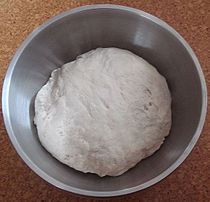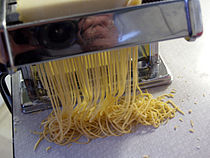Dough
Dough is a thick, malleable, sometimes elastic
Making and shaping dough begins the preparation of a wide variety of foodstuffs, particularly
Types of dough

Doughs vary widely depending on ingredients, the desired end product, the
There are several general classes of dough:
- Yeast-leavened or eggs will produce bread products of varying texture. Commercial bread dough may also include dough conditioners, which help make the dough and the final product more consistent.[citation needed]
- Doughs with higher fat content that contain less water develop less gluten and are therefore generally less elastic than bread doughs. They tend to become tough when they are kneaded.pie doughs such as shortcrust pastry.[1]
- or a dough.

- Laminated dough such as mille-feuille and puff pastry where a prepared flour dough is folded over fat (usually butter) and rolled out. The folding and rolling process can be repeated to create very thin layers of dough and butter to create the puff pastry. There are many different techniques to create laminated doughs and some like paratha are relatively simple while others like mille-feuille are more laborious.[3] Most laminated doughs are leavened only by the steam created by the folding process. Danish pastry and croissant are sometimes considered a separate class of dough because they are made from laminated dough that is leavened with yeast.[4]
- churros. Unlike most other pastry doughs, the ingredients for the dough are cooked on the stovetop before the dough is baked until achieving the consistency of a thick paste. Choux means cabbage in French. It is thought that the name comes from the shape of the cream puffs made with choux paste.[4]
- Some
- Gluten free doughs like
- Unleavened bread is made not only from wheat but in many cultures has been made from locally available starchy ingredients like corn,
Sometimes meringue is considered a dough.[4] The English recipe for "Satan Biscuit" dates to 1677, and earlier recipes are known by different names. Some included flour like a 1604 recipe for "white bisket bread".[11]
Techniques
Techniques used in dough production depend on the type of dough and final product.[12]
For yeast-based and sponge (such as sourdough) breads, a common production technique is the dough is mixed, kneaded, and then left to rise. Many bread doughs call for a second stage, where the dough is kneaded again, shaped into the final form, and left to rise a final time (or proofed) before baking.[13] Kneading is the process of working a dough to produce a smooth, elastic dough by developing gluten.[13] This process is both temperature and time-dependent; temperatures that are either too hot or too cold will cause the yeast to not develop, and rising times that are either too short or too long will affect the final product.[citation needed]
Doughs for
While breads and other products made from doughs are often baked, some types of dough-based foods are cooked over direct heat, such as tortillas, which are cooked directly on a griddle. Fried dough foods are also common in many cultures.
-
Dough being kneaded
-
Yeast bread dough after kneading, before rising
-
Yeast bread dough after rising (proofing), for 40 minutes
-
Dough being cut into noodles with a pasta machine
See also
- Baking
- Bread trough
- Dough blender
- Dough scraper
- Doughboy (disambiguation)
- Farinograph – a tool that measures specific properties of flour
- List of breads
- List of fried dough foods
- List of pasta
- List of pastries
- Parchment paper
- Proofing (baking technique)
- Roller docker
- Royal icing
- Straight dough
- Stuffing
References
- ^ .
- ^ "This is how to make perfect shortcrust pastry". Good Housekeeping.
- ^ Goldstein Darra. 2015. The Oxford Companion to Sugar and Sweets. Oxford: Oxford University Press.
- ^ a b c Alan Davidson. National & Regional Styles of Cookery: Proceedings: Oxford Symposium. 1981.
- ^ Heinzelmann Ursula. 2008. Food Culture in Germany. Westport Conn: Greenwood Press.
- ^ Culinary Institute of America. 2011. The Professional Chef. 9th ed. Hoboken N.J: John Wiley & Sons.
- ^ Thaker Aruna and Arlene Barton. 2012. Multicultural Handbook of Food Nutrition and Dietetics. Chichester West Sussex UK: Wiley-Blackwell.
- ^ McGee Harold. 2004. On Food and Cooking : The Science and Lore of the Kitchen Completely rev. and updated ed. New York: Scribner.
- ^ Tylor, Edward Burnett (1881). Anthropology: an introduction to the study of man and civilization.
- ^ Cooking through History: A Worldwide Encyclopedia of Food with Menus and Recipes. 2020. ABC-CLIO.
- ^ Day Ivan. 2009. Cooking in Europe 1650-1850. Westport Conn: Greenwood Press.
- ^ Rathod, Anurag (2023-02-09). "From Antiquated to Advanced: The History of Pizza Dough Rollers". Darbaar.com. Retrieved 2023-02-23.
- ^ ISBN 0684818701.
- ISBN 9783527324682. This reference is specifically about cake batter.
Further reading
- Cuvain, Stanley; Linda S. Young (2007). Technology of Breadmaking (2 ed.). Springer. ISBN 9780387385655.—covers commercial dough production
- DiMuzio, Daniel (2009). Bread Baking: An Artisan's Perspective. Wiley. ISBN 978-0470138823.—covers home and commercial baking and dough techniques
- Hamelman, Jeffrey (2004). Bread: A Baker's Book of Techniques and Recipes. Wiley. ISBN 978-0471168577.—covers home and commercial baking and dough techniques





